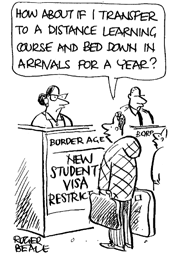What you need to know before deciding where to study and work abroad between the US, UK, Canada or Australia.
Getting a post-study work permit in a foreign country of choice is easy but different countries have different requirements. Knowing these is an advantage when choosing where to study.
Presented is an overview of post-study work opportunities in the four most popular English-speaking destinations for international students.
UK
Students graduating from British universities have been traditionally entitled to 3 years of post-study work experience. Up until the 5th of April 2012, this was classified as Tier 1 immigration and virtually everyone getting a UK degree could stay in the country either working or being self-employed.
Starting from the spring of 2012, work permit applications are no longer accepted. Not everyone can now get a “leave to stay,” as the British Border Agency calls a post-study immigration status. The eligibility is now calculated on a points basis and it is the Tier 2 (skilled workers) category that students should apply to. Your command of English, whether you have a sponsor, funds, etc., are now worth points.
The more points you have – the more likely you are to receive a work permit.
If you dig into it a little, it follows from the new points-based system that a valid Certificate of Sponsorship (CoS) is required. A points calculator on the UK Border Agency website shows that: command of English is worth 10 points Ability to maintain a minimum of 900 British pounds in your bank account for a period of 90 days is worth another 10 points “Appropriate salary” of at least 20 thousand pounds per annum is worth 20 points
Combine that and you have 40 points which is not enough.
It is the Certificate of Sponsorship from one of the British companies that’s worth 30 points and that’s essential to the issuing of a work permit.
Not all companies can sponsor a foreign worker though and that’s where another difficulty lies.
You can learn more about the new points-based system here.
Australia
Australian post-study immigration opportunities are also about to face changes in 2013.
Undergraduate students will be now allowed to stay and work for up to 2 years instead of 18 months. Graduate and post-graduate degree students will be entitled to 3 and 4 years or work in Australia respectively.
Getting a post-study work permit in Australia is easier than in other countries and is subject to less bureaucracy, with roughly 80% of all Bachelor’s degree-holding international students finding employment in Australia after finishing their studies.
This number will only increase following the new policy’s implementation in 2013. Perhaps the country will experience a greater inflow of students from Europe, Africa and CIS states in particular – places where Australia has not yet been established as a popular international student destination.
As of right now, the majority of international students coming to Australian universities are from Southeast Asia, India and Japan.
The Australian immigration system is unique and very different from other countries’. Every applicant is given “an assessment level.” It signifies how likely the person is to break the immigration law. Country of origin, criminal background etc. are taken into account. The higher the assessment level, the more evidence the applicant would need to provide to the authorities.
Learn more about Australian student visas here.
Canada
The Canadian government allows international students to work for a period of time equal to the length of their studies but no longer than 3 years (4 years for PhDs).
Only those who have studied in the country for 8 months or more in a post-secondary college or a university are eligible to apply.
Not all private institutions qualify, and the applicant would have to check with the immigration authorities whether their school qualifies.
No job offer is needed to apply for the work permit. Same as with the United States, a driver’s license and a car are highly recommended, but again that’s only if not living in Toronto, Ottawa, Montreal, Vancouver or some other major city.
One unique thing about the Canadian immigration law is that it allows those who have taken the post-study opportunity to obtain the Canadian citizenship. The Canadian government calls this the Canadian Experience Class program.
Learn more about the getting a work visa in Canada here.
USA
The United States, being the #1 destination for international students, has been sticking to its immigration policies for decades now.
Every student completing an American degree is entitled to a one-year Optional Practical Training (OPT) period. Certificate programs don’t count. It has to be either Bachelor’s, Master’s or some other degree that you complete.
If you complete both Bachelor’s and Master’s in the U.S., you are entitled to two OPT periods.
The OPT period can be extended up to 16 months for STEM (science, technology, engineering, math) graduates. No job offer needed to apply, just a recommendation from the head of the international student office at the university you went to. In fact, all respected universities take care of the application process for their students.
The major difficulty is getting the Social Security Number (SSN) and the driver’s license. You would need the former to pay taxes if working and you would surely need the latter unless you are living in one of the major cities. It is in your best interest to get both while still studying by getting an on-campus job and through getting a car early on.
Staying beyond the OPT period is somewhat problematic though. The only way to stay in the country is to get a green card (i.e. permanent residence) or a working visa (H1). The latter is often problematic with a limited number of companies allowed to sponsor international students and with an even smaller amount of companies willing to do so.
Learn more about applying for OPT here.
Conclusion
Countries are now literally fighting for international students.
With their competitors the European universities charging little to no fees, standing out in terms of quality of education and long-term return on investment becomes essential to English-speaking countries.
In the examples of Australia and Canada, we can see how countries update their immigration policies to attract more students from abroad and in the example of the United Kingdom, we can see how a country seeks to control the international student body.
With this in mind, 2013 seems to be the perfect time to jump into the educational systems of Canada and Australia.
About the Author
 This guest post was written by Katy Heger, an editor from WriteMyPapers.org. What she does best is writing powerful content.
This guest post was written by Katy Heger, an editor from WriteMyPapers.org. What she does best is writing powerful content.
READ NOW: Lindsey Pollak: How Students and Graduates Should Be Job Searching Right Now
Subscribe to JobMob via RSS or email and follow me on Twitter for more funny tips on good decisions for your future.
Youll Enjoy These Articles Too 56 Israel Chambers of Commerce for Jobs in Israel or Abroad Work Portfolios: The Best Job Interview Tool You’re Not Using Reader Question: Job Searching at Work? Stand Out With The One Page Resume Work Portfolio The One Thing Your Personal Brand Must Have to Work












